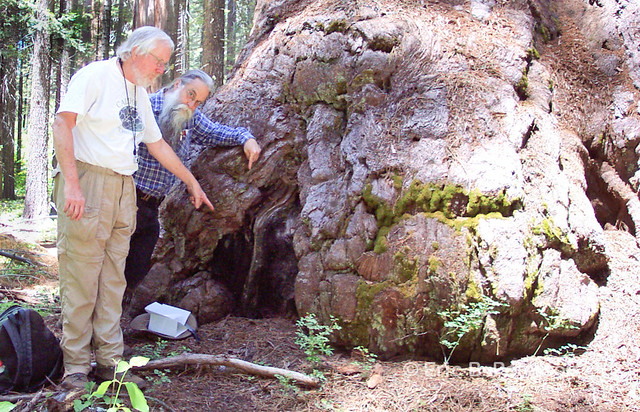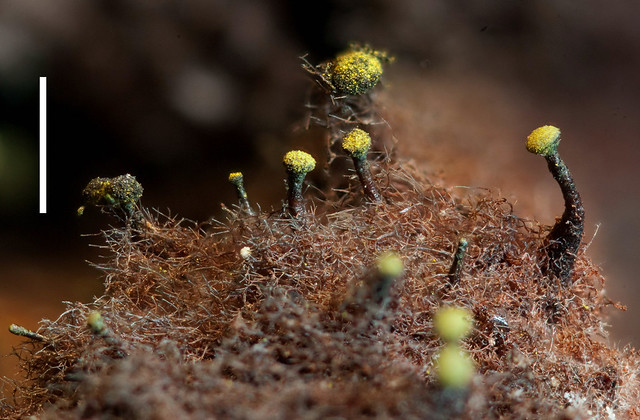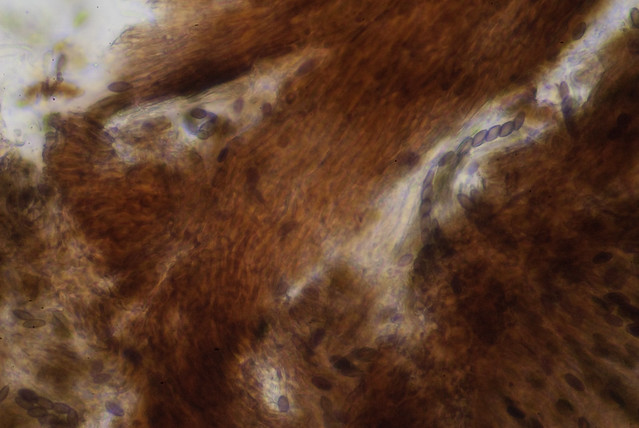Xataface
Crustose.net HOME
Top
- HOME
- Introduction
- History of "Caliciales" and the Origin of the "Calicioids"
- Biogeography of Calicioids
- Calicioid Ecology and Habitats
- Conservation
- Zen and the Search for Calicioids
- Collecting and Curating
- Key to Genera
- Acolium
- Acroscyphus
- Allocalicium
- Bruceomyces
- Calicium
- Chaenotheca
- Chaenothecopsis
- Cyphelium
- Cryptocalicium
- Microcalicium
- Mycocalicium
- Phaeocalicium
- Pseudothelomma
- Sclerophora
- Sphinctrina
- Stenocybe
- Texosporium
- Thelomma
- Tholurna
- "Within-bark"
- Glossary
- References
0.01 (development)
Eric B. Peterson
Mycocalicium
This genus is distinguished from Chaenothecopsis by the lack of an apical canal in the ascus tip. It also can resemble Stenocybe or Phaeocalicium in some cases, but can be easily distinguished by the smaller, simple spores.
Taxa covered (15):
Mycocalicium "mazaedia"
Mycocalicium albonigrum
Mycocalicium americanum
Mycocalicium anomalum
Mycocalicium calicioides
Mycocalicium chaudhari
Mycocalicium fulvofuscum
Mycocalicium fuscipes
Mycocalicium llimonae
Mycocalicium rapax
Mycocalicium ravenelii
Mycocalicium reticulatum
Mycocalicium sequoiae
Mycocalicium subtile
Mycocalicium victoriae
Mycocalicium albonigrum
Mycocalicium americanum
Mycocalicium anomalum
Mycocalicium calicioides
Mycocalicium chaudhari
Mycocalicium fulvofuscum
Mycocalicium fuscipes
Mycocalicium llimonae
Mycocalicium rapax
Mycocalicium ravenelii
Mycocalicium reticulatum
Mycocalicium sequoiae
Mycocalicium subtile
Mycocalicium victoriae
Key to Species
Warning: keys are incomplete.
Validation script believes all taxa are included in the key(s).
-
- 2a. ?.Mycocalicum cervinum
- 2b. ?.Mycocalicium llimonae
- 2c. .Mycocalicium rapax
-
- 3a. Mazaedium itself brown, K+green, on exudate.Mycocalicium chaudhari
-
- 4a. Excipulum with brown pruina, K+R, spore wall exceptionally thick.Mycocalicium fulvofuscum
- 4b. Excipulum brownish black (pruina?), K ?, spore wall probably not as above. {need to find good references for this].Mycocalicium rappii
-
-
- 6a. Stalks growing from a black pseudostroma over exudate on scarred trees of Sequoiadendron or Sequoia.Mycocalicium sequoiae
- 6b. Growing on lignum.Mycocalicium calicioides
-
-
- 8a. Thallus present, granulose, greenish-grey.Mycocalicium ravenelii
-
- 9a. Margin of excipulum strongly thickened.Mycocalicium americanum
- 9b. Margin of excipulum not strongly thickened.Mycocalicium subtile
-
-
- 11a. Excipulum white pruinose, apothecia small, thallus not visible.Mycocalicium fuscipes
- 11b. Excipulum epruinose, thallus granulose, greenish grey.Mycocalicium ravenelii
-
-
- 13a. Spores 8-9 um, K+ intensified reddish.Mycocalicium victoriae
- 13b. Spores 6-7 um, K-.Mycocalicium anomalum
- 12b. Central part of stalk dark greenish to dark brownish, though possibly more pale than outer part of stalk, spores 5.5-10μm.
-
- 15a. Cells isodiametric, 8-13μm in diameter.Mycocalicium albonigrum
- 15b. Cells isodiametric to slightly elongate, 15-20 X 20μm.Mycocalicium reticulatum
- 14b. Excipulum at the base consisting of periclinally arranged, sclerotized hyphae or a pserudoparenchymatic tissue consisting of rather small (4-6μm) cylindrical or isodiametric cells with thickened walls.
- 16a. Spores allantoid, 5.5-9μm long.Mycocalicium subtile
- 16b. Spores oblong-ellipsoidal, 6.5-10μm.Mycocalicium rappii
-
-
-
-
-
Step number 2 has 4 options!
Species Details
Mycocalicium "mazaedia"
ID=237
Type(s):
Synonyms:



Habit and Morphology:
Anatomy:
Chemistry:
Habitat:
Biogeography:
Global Rank:
Conservation:
Notes:
External Information:
ID=237
Type(s):
Synonyms:
Unspecified collections:

Mycocalicium sp. nov. SCL16925
Mycocalicium sp. nov. from "Imperatrice" near Ashland, OR. Pruinosity on excipulum is variable; many ascomata lack pruina. Scot Loring # SCL16925. Ca. 9x.

Mycocalicium sp. nov. SCL16925
Ascospores with a hint of a longitudinal ornamentation. Scot Loring # SCL16925. 1000x

Mycocalicium sp. nov. SCL16925
Ascus with thickened tip (typical of genus Mycocalicium). Scot Loring # SCL16925. 1000x with Methylene Blue.
Habit and Morphology:
Anatomy:
Chemistry:
Habitat:
Biogeography:
Global Rank:
Conservation:
Notes:
Found by Scot Loring at "Imperatrice" near Ashland, OR, specimen number SCL16925.
External Information:
 Index Fungorum: ID=
Index Fungorum: ID= Encyclopedia of Life (EOL): Search
Encyclopedia of Life (EOL): Search - CNALH: Search
- NatureServe:
 ODBaL Search
ODBaL SearchNucleotide Search
Mycocalicium albonigrum (Nyl.) Fink
ID=139
Type(s):
Synonyms:
Habit and Morphology:
Anatomy:
Chemistry:
Habitat:
Biogeography:
Global Rank:
Conservation:
Notes:
External Information:
ID=139
Type(s):
Synonyms:
Unspecified collections:
Habit and Morphology:
Anatomy:
Chemistry:
Habitat:
Biogeography:
Global Rank:
Conservation:
Notes:
External Information:
 Index Fungorum: ID=
Index Fungorum: ID= Encyclopedia of Life (EOL): Search
Encyclopedia of Life (EOL): Search - CNALH: Search
- NatureServe:
 ODBaL Search
ODBaL SearchNucleotide Search
Mycocalicium americanum (R. Sant.) Tibell
ID=140
Type(s):
Synonyms:
Habit and Morphology:
Anatomy:
Chemistry:
Habitat:
Biogeography:
Global Rank:
Conservation:
Notes:
External Information:
ID=140
Type(s):
Synonyms:
Habit and Morphology:
Anatomy:
Chemistry:
Habitat:
Biogeography:
Global Rank:
Conservation:
Notes:
External Information:
 Index Fungorum: ID=
Index Fungorum: ID= Encyclopedia of Life (EOL): Search
Encyclopedia of Life (EOL): Search - CNALH: Search
- NatureServe:
 ODBaL Search
ODBaL SearchNucleotide Search
Mycocalicium anomalum Tibell
ID=141
Type(s): -1998
Synonyms:
Habit and Morphology:
Anatomy:
Chemistry:
Habitat:
Biogeography:
Global Rank:
Conservation:
Notes:
External Information:
ID=141
Type(s): -1998
Synonyms:
Habit and Morphology:
Anatomy:
Chemistry:
Habitat:
Biogeography:
Global Rank:
Conservation:
Notes:
External Information:
 Index Fungorum: ID=
Index Fungorum: ID= Encyclopedia of Life (EOL): Search
Encyclopedia of Life (EOL): Search - CNALH: Search
- NatureServe:
 ODBaL Search
ODBaL SearchNucleotide Search
Mycocalicium calicioides (N?dv.) Tibell
ID=142
Type(s):
Synonyms:
Habit and Morphology:
Anatomy:
Chemistry:
Habitat:
Biogeography:
Global Rank:
Conservation:
Notes:
External Information:
ID=142
Type(s):
Synonyms:
Habit and Morphology:
Anatomy:
Chemistry:
Habitat:
Biogeography:
Global Rank:
Conservation:
Notes:
External Information:
 Index Fungorum: ID=
Index Fungorum: ID= Encyclopedia of Life (EOL): Search
Encyclopedia of Life (EOL): Search - CNALH: Search
- NatureServe:
 ODBaL Search
ODBaL SearchNucleotide Search
Mycocalicium chaudhari Tewari & Pant
ID=144
Type(s):
Synonyms:
Habit and Morphology:
Anatomy:
Chemistry:
Habitat:
Biogeography:
Global Rank:
Conservation:
Notes:
External Information:
ID=144
Type(s):
Synonyms:
Habit and Morphology:
Anatomy:
Chemistry:
Habitat:
Biogeography:
Global Rank:
Conservation:
Notes:
External Information:
 Index Fungorum: ID=
Index Fungorum: ID= Encyclopedia of Life (EOL): Search
Encyclopedia of Life (EOL): Search - CNALH: Search
- NatureServe:
 ODBaL Search
ODBaL SearchNucleotide Search
Mycocalicium fulvofuscum (F. Wilson ex Bailey) Tibell
ID=146
Type(s):
Synonyms:
Habit and Morphology:
Anatomy:
Chemistry:
Habitat:
Biogeography:
Global Rank:
Conservation:
Notes:
External Information:
ID=146
Type(s):
Synonyms:
Habit and Morphology:
Anatomy:
Chemistry:
Habitat:
Biogeography:
Global Rank:
Conservation:
Notes:
External Information:
 Index Fungorum: ID=
Index Fungorum: ID= Encyclopedia of Life (EOL): Search
Encyclopedia of Life (EOL): Search - CNALH: Search
- NatureServe:
 ODBaL Search
ODBaL SearchNucleotide Search
Mycocalicium fuscipes (Tuck.) Fink
ID=145
Type(s):
Synonyms:
Habit and Morphology:
Anatomy:
Chemistry:
Habitat:
Biogeography:
Global Rank:
Conservation:
Notes:
External Information:
ID=145
Type(s):
Synonyms:
Habit and Morphology:
Anatomy:
Chemistry:
Habitat:
Biogeography:
Global Rank:
Conservation:
Notes:
External Information:
 Index Fungorum: ID=
Index Fungorum: ID= Encyclopedia of Life (EOL): Search
Encyclopedia of Life (EOL): Search - CNALH: Search
- NatureServe:
 ODBaL Search
ODBaL SearchNucleotide Search
Mycocalicium llimonae Hladun & Mu?iz
ID=147
Type(s): Mu?iz & Hladun 2007
Synonyms:
Habit and Morphology:
Anatomy:
Chemistry:
Habitat:
Biogeography:
Global Rank:
Conservation:
Notes:
External Information:
ID=147
Type(s): Mu?iz & Hladun 2007
Synonyms:
Habit and Morphology:
Anatomy:
Chemistry:
Habitat:
Biogeography:
Global Rank:
Conservation:
Notes:
External Information:
 Index Fungorum: ID=
Index Fungorum: ID= Encyclopedia of Life (EOL): Search
Encyclopedia of Life (EOL): Search - CNALH: Search
- NatureServe:
 ODBaL Search
ODBaL SearchNucleotide Search
Mycocalicium rapax Tibell
ID=238
Type(s): Tibell (2001)
Synonyms:
Habit and Morphology:
Anatomy:
Chemistry:
Habitat:
Biogeography:
Global Rank:
Conservation:
Notes:
External Information:
ID=238
Type(s): Tibell (2001)
Synonyms:
Habit and Morphology:
Anatomy:
Chemistry:
Habitat:
Biogeography:
Global Rank:
Conservation:
Notes:
External Information:
 Index Fungorum: ID=
Index Fungorum: ID= Encyclopedia of Life (EOL): Search
Encyclopedia of Life (EOL): Search - CNALH: Search
- NatureServe:
 ODBaL Search
ODBaL SearchNucleotide Search
Mycocalicium ravenelii (Tuck.) Fink
ID=148
Type(s):
Synonyms:
Habit and Morphology:
Anatomy:
Chemistry:
Habitat:
Biogeography:
Global Rank:
Conservation:
Notes:
External Information:
ID=148
Type(s):
Synonyms:
Habit and Morphology:
Anatomy:
Chemistry:
Habitat:
Biogeography:
Global Rank:
Conservation:
Notes:
External Information:
 Index Fungorum: ID=
Index Fungorum: ID= Encyclopedia of Life (EOL): Search
Encyclopedia of Life (EOL): Search - CNALH: Search
- NatureServe:
 ODBaL Search
ODBaL SearchNucleotide Search
Mycocalicium reticulatum N?dv.
ID=149
Type(s):
Synonyms:
Habit and Morphology:
Anatomy:
Chemistry:
Habitat:
Biogeography:
Global Rank:
Conservation:
Notes:
External Information:
ID=149
Type(s):
Synonyms:
Habit and Morphology:
Anatomy:
Chemistry:
Habitat:
Biogeography:
Global Rank:
Conservation:
Notes:
External Information:
 Index Fungorum: ID=
Index Fungorum: ID= Encyclopedia of Life (EOL): Search
Encyclopedia of Life (EOL): Search - CNALH: Search
- NatureServe:
 ODBaL Search
ODBaL SearchNucleotide Search
Mycocalicium sequoiae Bonar
ID=150
Type(s):
Synonyms:

Habit and Morphology:
Anatomy:
Chemistry:
Habitat:
Biogeography:
Global Rank:
Conservation:
Notes:
External Information:
ID=150
Type(s):
Synonyms:
Unspecified collections:

Habitat of Mycocalicium sequoiae
California Lichen Society members Boyd Poulsen and Bill Hill point to typical habitat.
Habit and Morphology:
Anatomy:
Chemistry:
Habitat:
Biogeography:
Global Rank:
Conservation:
Notes:
External Information:
 Index Fungorum: ID=
Index Fungorum: ID= Encyclopedia of Life (EOL): Search
Encyclopedia of Life (EOL): Search - CNALH: Search
- NatureServe:
 ODBaL Search
ODBaL SearchNucleotide Search
Mycocalicium subtile (Pers.) Szatala
ID=151
Type(s):
Synonyms:
Habit and Morphology:
Anatomy:
Chemistry:
Habitat:
Biogeography:
Global Rank:
Conservation:
Notes:
External Information:
ID=151
Type(s):
Synonyms:
Habit and Morphology:
Anatomy:
Chemistry:
Habitat:
Biogeography:
Global Rank:
Conservation:
Notes:
External Information:
 Index Fungorum: ID=
Index Fungorum: ID= Encyclopedia of Life (EOL): Search
Encyclopedia of Life (EOL): Search - CNALH: Search
- NatureServe:
 ODBaL Search
ODBaL SearchNucleotide Search
Mycocalicium victoriae (C. Knight & F. Wilson) N?dv.
ID=152
Type(s): (Tibell 2007)
Synonyms:
Habit and Morphology:
Anatomy:
Chemistry:
Habitat:
Biogeography:
Global Rank:
Conservation:
Notes:
External Information:
ID=152
Type(s): (Tibell 2007)
Synonyms:
Habit and Morphology:
Anatomy:
Chemistry:
Habitat:
Biogeography:
Global Rank:
Conservation:
Notes:
External Information:
 Index Fungorum: ID=
Index Fungorum: ID= Encyclopedia of Life (EOL): Search
Encyclopedia of Life (EOL): Search - CNALH: Search
- NatureServe:
 ODBaL Search
ODBaL SearchNucleotide Search
Count of taxa = 15

















-2.jpg)

